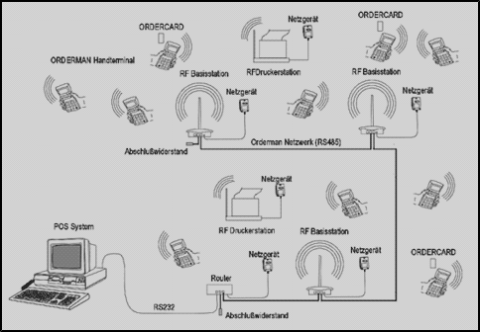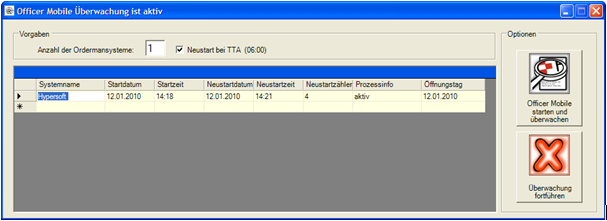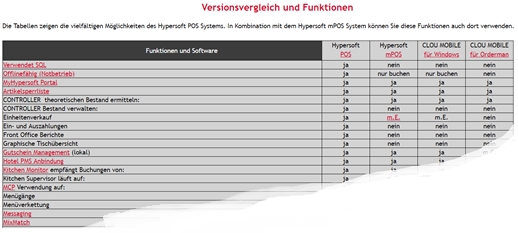CLOU MOBILE for Orderman
Reminder for the cancellation of the old Orderman integration. Support for the old Orderman integration will be discontinued at the end of 2024. This means for you: If you are still working with the old Orderman and Hypersoft, this will no longer be possible after an update.
- - Discontinued - -
The program will not be developed further. Please change your workflow. Information on follow-up programmes, announcements and discontinuations, or alternatives can be found here: Discontinuation of Hypersoft products
Hypersoft develops to the CLOU POS system on the basis of the Orderman DON/MAX a powerful mobile POS system. The Orderman DON or MAX are mobile POS terminals which communicate via radio with an Orderman base station. The CLOU is enabled by the program CLOU MOBILE for Orderman to control the DON or MAX, as well as other Orderman devices. The handling largely corresponds to the usual CLOU standard.
The CLOU MOBILE for Orderman masters all functions to enter individual orders directly at the customer or to carry out billing. Programming the CLOU MOBILE for Orderman works like programming a CLOU cash register. The range of the mobile devices depends on various factors (buildings, battery, etc.) but should be at least between 60 and 100 meters. It can be extended by further antennas, which are connected to each other.
In the chapter Technology and Hardware we discuss the radio range among other things.
Further documentation:
Programmes of the CLOU MOBILE for Orderman
The CLOU MOBILE for Orderman consists of two programs. The CLOU MOBILE for Orderman server program and the CLOU MOBILE for Orderman client program. The server program managed the interface of the Orderman devices via the Orderman base station (antenna) to the Hypersoft Suite. The client programs each represent one Orderman device, i.e. the client program is started once per Orderman device.
The Orderman network can consist of different devices. Representation of an Orderman "network":

If you use more than one base station, they will be connected via special Orderman routers. The Orderman radio network is always based on wired base stations.
Each CLOU-Mobile server can therefore manage one base station or one router (with several base stations). However, if you use more than one CLOU-Mobile server, these are differentiated as mobile systems (only necessary within one client). Each is designated as its own mobile system and set up accordingly in the Basis register. So that you can differentiate between the systems, enter a unique name for Mobile System Name.
The CLOU MOBILE for Orderman Server is started together with the CLOU MOBILE for Orderma Monitoring. Here the set number of systems should correspond to the number of systems used (standard 1).

If you are working with more than one CLOU MOBILE for Orderman Server, you need to keep a few things in mind:
A CLOU MOBILE for Orderman device working in more than one range may be received in both ranges. In this case the CLOU MOBILE for Orderman Server prevents the second login by saving the information of the corresponding base station or router at the first login to the serial number of the mobile device and allowing the device only once (single use). To remove a serial number from a base station or router, you must turn off the mobile device and restart the assigned CLOU MOBILE for Orderman Server once.
However, if you are sure that the radio ranges of the different mobile systems do not overlap, you can use the same mobile devices in several areas. To do this, you can activate the Multiple Use option for each suitable mobile device in the Serial Number Management tab.
Make sure that multiple use is a supported exception. We assume no liability for any damage to the data (information) that may occur as a result of the overlapping of the radio ranges that is incompatible with this function.
Recommendation from Hypersoft: You should use a maximum of 6 mobile Orderman devices per antenna. With an extremely high number of bookings, there should even be less than 6 devices.
With many devices we can set up the Orderman systems in such a way that one computer simultaneously addresses several routers (or base stations) via several interfaces. This results in an additional distribution of the load. The use of several CLOU-Mobile servers on one client is project work requiring planning:
This topic concerns project work that is subject to planning.
The Hypersoft // system is a standard programme that can be used in many different configurations. The correct application of the topics described here requires expert knowledge and an alignment of expectations, and not all Hypersoft employees and partners are equally trained in all of the topics labelled in this way. For this reason, we characterise these topics as project work requiring planning, so that you can contact your Hypersoft sales partner or Hypersoft Support in good time with this necessary planning. This approach ensures that we record your requirements carefully and respond to them in a targeted manner.
Variants of multiple use
There are two more ways to work with more than one base station within a client.
The first variant uses an Orderman router. This controls several antennas and is controlled by a mobile server.
If a router cannot be used, it can be configured as follows:
It is also possible to start an antenna and thus a CLOU-Mobile server within one client per POS station. The special feature is that all POS systems start with one and the same CLOU-Mobile server configuration, which means that e.g. all antennas must be configured at the same port, for example COM 1 at each POS system (a mixed configuration is not supported).
The individual CLOU-Mobile devices are only logged on to the CLOU-Mobile server on which they are to be used. Although the serial numbers then appear in the lists of the other CLOU-Mobile servers, the devices cannot be used there with this variant.
A change of the individual CLOU-Mobile devices from one POS station to another is not supported. Check whether the Local operations setting must be activated. If necessary, Smart-Swap is used more intensively in this configuration.
Further documentation: Store operations on...
Requirements for operating CLOU MOBILE for Orderman
- A keyboard for the Orderman device (MAX or DON) must be set up.
- CLOU MOBILE for Orderman Server must be installed and started.
- Cashier mode or subsystem must be started.
The keyboards can be set up for the functions that are enabled for use with the CLOU mobile. So before you plan to use the CLOU-Mobile on the basis of your CLOU cash register functions, make sure that the desired functions are also supported on the CLOU-Mobile.
A CLOU MOBILE for Orderman keyboard can be added as a subsystem with appropriate settings (keyboard = DON / MAX) in the station details or directly to an existing POS station. To add the keyboard directly to a cash register, press the Orderman button in the station details.
Further documentation:
Hardware Connection
The hardware installation is limited to connecting the Orderman base station to the PC or POS terminal. Connect the base station to the PC using the supplied serial cable. The base station must be supplied with power via the supplied plug-in power supply unit. If you are using an Orderman DON or MAX not supplied by Hypersoft, you must set up the keyboard layout using a special program from Orderman.
Set up subsystem
If the CLOU-Mobile runs with the CLOU on a terminal, we recommend setting up a subsystem to control the CLOU-Mobile server.
Further documentation: mPOS and CLOU-MOBILE for Orderman
Version comparison and functions
Most functions are supported by all Hypersoft POS versions, but there are also variations so that special functions are available for some of the POS versions. You can find an overview of this situation under: Version comparison and functions

Further documentation: CLOU MOBILE for Orderman functions
Back to the parent page: Older programs